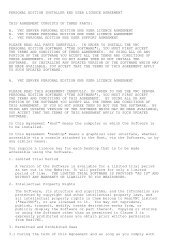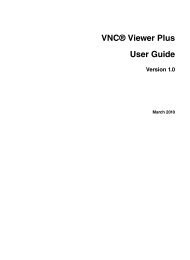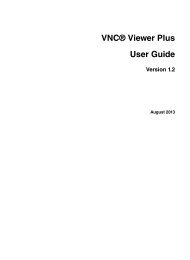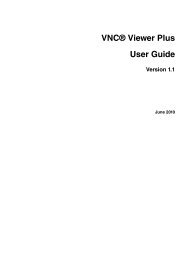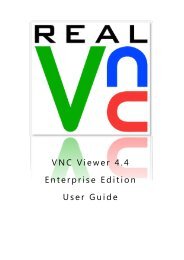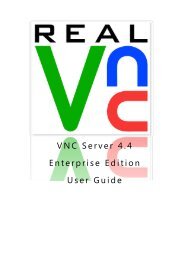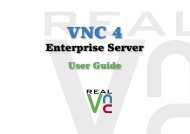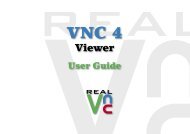VNC User Guide - RealVNC
VNC User Guide - RealVNC
VNC User Guide - RealVNC
You also want an ePaper? Increase the reach of your titles
YUMPU automatically turns print PDFs into web optimized ePapers that Google loves.
7<br />
Making Connections Secure<br />
<strong>VNC</strong> Server (Enterprise) and <strong>VNC</strong> Server (Personal) are designed to permit authenticated and encrypted<br />
connections between a host and any number of client computers out-of-the-box. This chapter explains how<br />
to configure <strong>VNC</strong> Server to relax the authentication and encryption rules if you consider it safe to do so.<br />
Conversely, you can tighten the encryption rules for <strong>VNC</strong> Server (Enterprise) if required.<br />
Note: <strong>VNC</strong> Server (Free) can only authenticate connections. Upgrade the host computer to <strong>VNC</strong> Server<br />
(Enterprise) or <strong>VNC</strong> Server (Personal) if security is important to you.<br />
This chapter also explains how to configure <strong>VNC</strong> Server to protect the host computer from accidental or<br />
malicious damage by particular connected users, either by restricting their access to Real<strong>VNC</strong> remote<br />
control features while connections are in progress, or by preventing them from connecting in the first place.<br />
Contents<br />
Authenticating connections to <strong>VNC</strong> Server 98<br />
Relaxing the authentication rules 104<br />
Bypassing the authentication rules 107<br />
Changing the encryption rules 109<br />
Preventing particular connections to <strong>VNC</strong> Server 111<br />
Restricting features for particular connected users 114<br />
Uniquely identifying <strong>VNC</strong> Server 118<br />
Protecting privacy 118<br />
<strong>VNC</strong> <strong>User</strong> <strong>Guide</strong> 97



